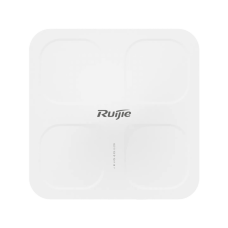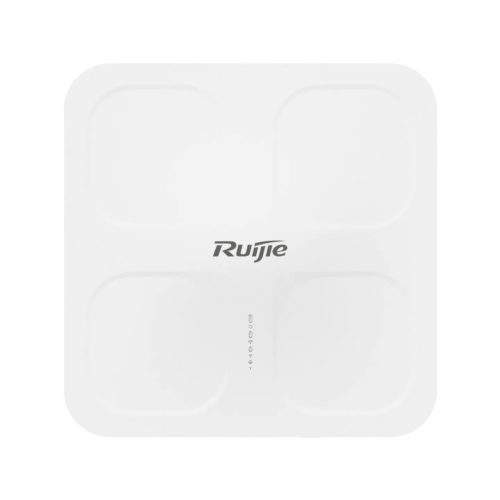RG-AP680-IO, Wi-Fi 6 Dual-Radio 5.951 Gbps Outdoor Access Point, Omnidirectional Antennas Best Price In Dubai, UAE.
Availability:
In Stock
Outdoor scenarios covering higher education, wireless city, energy, and plaza scenarios
Highlight Features
- 10G optical port and 5G Ethernet port for flexible networking
- Built-in omnidirectional antennas, wide Wi-Fi coverage
- 5.951 Gbps high speed with 160 MHz band
- Industrial-grade product design, IP68 rating, 6 kV lightning protection
- Unified WIS cloud management, intelligent O&M
Description
Key Specification
Product Overview
The RG-AP680-IO is an 802.11ax-compliant dual-radio wireless access point (AP) provided by Ruijie Networks and is fit for higher education, wireless city, energy, and plaza scenarios. It complies with 802.11ax, 802.11ac Wave2, 802.11ac Wave1, and 802.11n. With a hardware-independent dual-radio design, the RG-AP680-IO can provide a data rate of up to 5.951 Gbps. The ultra-fast wireless rate eliminates the performance bottleneck.
The design of the RG-AP680-IO considers factors such as wireless network security, radio control, mobile access, QoS, seamless roaming, and Internet of Things (IoT) scalability. With Ruijie's access controller (AC) and Ruijie Cloud servers, the RG-AP680-IO can implement wireless client data forwarding, security features, access control, and IoT application extension. The RG-AP680-IO adopts IP68 rated housing. It is applicable to harsh outdoor environments and easy to install and maintain.
Product Highlights
Wi-Fi 6 certification
Data rate of up to 5.951 Gbps and concurrent dual-radio design
Up to 1024 client connections
Built-in smart omnidirectional antenna
Excellent environmental adaptability: IP68, –40°C to +65°C (–40ºF to +149ºF), and 6 kV surge protection
OFDMA, MU-MIMO technologies for minimal wireless signal interference
Hybrid management: support for thousands of standalone APs, and AC management and public cloud deployment options
Mobile management: free mobile applications for Ruijie Cloud customers
Specifications
Hardware Specifications
| Hardware Specifications |
RG-AP680-IO |
| 802.11n |
Eight spatial streams ● Radio 1 – 2.4 GHz: 4x4 MIMO, four spatial streams ● Radio 2 – 5 GHz: 4x4 MIMO, four spatial streams Channels: ● Radio 1 – 2.4 GHz: 20 MHz and 40 MHz ● Radio 2 – 5 GHz: 20 MHz and 40 MHz Combined peak data rate: 1.2 Gbps ● Radio 1 – 2.4 GHz: 6.5 Mbps to 600 Mbps (MCS0 to MCS31 ) ● Radio 2 – 5 GHz: 6.5 Mbps to 600 Mbps (MCS0 to MCS31) Radio technologies: Orthogonal Frequency-Division Multiplexing (OFDM) Modulation types: BPSK, QPSK, 16-QAM, 64-QAM, 256-QAM Packet aggregation: ● Aggregate MAC Protocol Data Unit (A-MPDU) ● Aggregate MAC Service Data Unit (A-MSDU) Dynamic Frequency Selection (DFS) Cyclic Delay/Shift Diversity (CDD/CSD) Maximum Ratio Combining (MRC) Space-Time Block Coding (STBC) Low-Density Parity Check (LDPC) Transmit beam-forming (TxBF) |
| 802.11ac |
Four spatial streams ● Radio 2 – 5 GHz: 4x4 MIMO, four spatial streams Channels: ● Radio 2 – 5 GHz: 20 MHz, 40 MHz, 80 MHz, and 160 MHz Combined peak data rate: 3.467 Gbps ● Radio 2 – 5 GHz: 6.5 Mbps to 3.467 Gbps (MCS0 to MCS9) Radio technologies: Orthogonal Frequency-Division Multiplexing (OFDM) Modulation types: BPSK, QPSK, 16-QAM, 64-QAM, 256-QAM, 1,024-QAM Packet aggregation: ● Aggregate MAC Protocol Data Unit (A-MPDU) ● Aggregate MAC Service Data Unit (A-MSDU) Dynamic Frequency Selection (DFS) Cyclic Delay/Shift Diversity (CDD/CSD) Maximum Ratio Combining (MRC) Space-Time Block Coding (STBC) Low-Density Parity Check (LDPC) Transmit beam-forming (TxBF) |
| 802.11ax |
Eight spatial streams ● Radio 1 – 2.4 GHz: 4x4 uplink/downlink MU-MIMO, four spatial streams ● Radio 2 – 5 GHz: 4x4 uplink/downlink MU-MIMO, four spatial streams Channels: ● Radio 1 – 2.4 GHz: 20 MHz and 40 MHz ● Radio 2 – 5 GHz: 20 MHz, 40 MHz, 80 MHz, and 160 MHz Combined peak data rate: 5.951 Gbps: ● Radio 1 – 2.4 GHz: 8.6 Mbps to 1.147 Gbps (MCS0 to MCS11) ● Radio 2 – 5 GHz: 8.6 Mbps to 4.804 Gbps (MCS0 to MCS11) Radio technologies: uplink/downlink Orthogonal Frequency-Division Multiple Access (OFDMA) Modulation types: BPSK, QPSK, 16-QAM, 64-QAM, 256-QAM, 1024-QAM Packet aggregation: ● Aggregate MAC Protocol Data Unit (A-MPDU) ● Aggregate MAC Service Data Unit (A-MSDU) Dynamic Frequency Selection (DFS) Cyclic Delay/Shift Diversity (CDD/CSD) Maximum Ratio Combining (MRC) Space-Time Block Coding (STBC) Low-Density Parity Check (LDPC) Transmit beam-forming (TxBF) WPA3 |
| Antenna |
Wi-Fi ● 2.4 GHz: four built-in omnidirectional antennas, the max. antenna gain is 6 dBi. ● 5 GHz: four built-in omnidirectional antennas, the max. antenna gain is 5 dBi. Bluetooth ● One integrated vertically polarized omnidirectional antenna, the max. antenna gain is 2 dBi. |
| Port |
1 x 100/1000/2500/5000Base-T RJ45 Ethernet port with auto-negotiation 1 x 100/1000Base-T RJ45 Ethernet port with auto-negotiation 1 x 10GE optical port,compatibility with 1GE and 2.5GE 1 x RJ45 console port (serial console port) 1 x Bluetooth 5.1 |
| Status LED |
1 x multi-color system status LED ● AP power-on status ● Software initialization status and upgrade status ● Uplink service interface status ● Wireless user online status ● CAPWAP tunnel timeout ● Specific AP locating Three single-color signal strength LEDs: ● Whether bridging is enabled ● Whether bridging is successful ● Wireless signal strength after successful bridging |
| Button |
1 x Reset button ● Press the button for shorter than 2 seconds. Then the device restarts. ● Press the button for longer than 5 seconds. Then the device restores to factory settings. |
| Dimensions (W x D x H) |
Main unit: 300 mm x 300 mm x 94 mm (11.8 in. x 11.8 in. x 3.7 in.) Shipping: 470 mm x 410 mm x 170 mm (18.5 in. x 16.1 in. x 6.7 in.) |
| Weight |
Main unit: 3.3 kg (7.28 lbs) Mounting bracket: 1.2 kg (2.65 lbs) Shipping: 6.5 kg (14.33 lbs) |
| Mounting |
Wall- or pole-mounting (a mounting bracket is delivered with the main unit) |
| Input power supply |
PoE input over LAN 1: The power source equipment (PSE) complies with IEEE 802.3af/at/bt standard (PoE/PoE+/PoE++). |
| Power consumption |
Maximum power consumption: 40 W ● 802.3bt (PoE+): 40 W, the AP operates with the optimal performance. ● 802.3at (PoE+): 12.95 W, the AP starts up normally. LAN 2 cannot supply power to external devices. ● 802.3af (PoE): 12.95 W, the AP starts up normally. Bluetooth and GPS work properly; all RF cards do not work; external power supply of the PSE is disabled. ● Idle mode: 10 W |
| Environment |
Storage temperature: –40°C to +85°C (–40°F to +185°F) Storage humidity: 0% RH to 100% RH (non-condensing) Operating temperature: –40°C to +65°C (-40°F to 149°F) Operating humidity: 0% RH to 100% RH (non-condensing) At an altitude between 3,000 m (9,842.52 ft.) and 5,000 m (16,404.20 ft.), every time the altitude increases by 166 m (546 ft.), the maximum temperature decreases by 1°C (1.8°F). |
| Mean Time Between Failure (MTBF) |
200,000 hours (22 years) at the operating temperature of 25°C (77°F) |
| System memory |
2 GB DRAM, 256 MB flash |
| Transmit power |
2.4 GHz ● Max. transmit power: 30 dBm (1,000 mW) 5 GHz ● Max. transmit power: 29 dBm (795 mW) Note: The transmit power adjusted in percentage. The transmit power is limited by local regulatory requirements. |
The following table lists the radio frequency performance of Wi-Fi including different frequency bands, protocols, and date rates. It is country-specific, and Ruijie Networks reserves the right of interpretation.
| Wi-Fi Radio Frequency Performance |
RG-AP680-IO |
||
| Frequency Band and Protocol |
Data Rate |
Max. Transmit Power per Transmit Chain |
Max. Receive Sensitivity per Receive Chain |
| 2.4 GHz 802.11b |
1 Mbps |
24 dBm |
–94 dBm |
| 2 Mbps |
24 dBm |
–91 dBm |
|
| 5.5 Mbps |
23 dBm |
–90 dBm |
|
| 11 Mbps |
22 dBm |
–88 dBm |
|
| 2.4 GHz 802.11g |
6 Mbps |
24 dBm |
–89.5 dBm |
| 24 Mbps |
23 dBm |
–83 dBm |
|
| 36 Mbps |
23 dBm |
–79 dBm |
|
| 54 Mbps |
21 dBm |
–73 dBm |
|
| 2.4 GHz 802.11n (HT20) |
MCS0 |
24 dBm |
–86 dBm |
| MCS7 |
21 dBm |
–68 dBm |
|
| 2.4 GHz 802.11n (HT40) |
MCS0 |
24 dBm |
–83 dBm |
| MCS7 |
21 dBm |
–65 dBm |
|
| 2.4 GHz 802.11ax (HE20) |
MCS0 |
24 dBm |
–86 dBm |
| MCS11 |
19 dBm |
–68 dBm |
|
| 2.4 GHz 802.11ax (HE40) |
MCS0 |
24 dBm |
–83 dBm |
| MCS11 |
19 dBm |
–65 dBm |
|
| 5 GHz 802.11a |
6 Mbps |
23 dBm |
–89.5 dBm |
| 24 Mbps |
22 dBm |
–83 dBm |
|
| 36 Mbps |
22 dBm |
–79 dBm |
|
| 54 Mbps |
20 dBm |
–73 dBm |
|
| 5 GHz 802.11n (HT20) |
MCS0 |
23 dBm |
–86 dBm |
| MCS7 |
20 dBm |
–68 dBm |
|
| 5 GHz 802.11n (HT40) |
MCS0 |
23 dBm |
–83 dBm |
| MCS7 |
20 dBm |
–65 dBm |
|
| 5 GHz 802.11ac (VHT20) |
MCS0 |
23dBm |
–86 dBm |
| MCS9 |
19 dBm |
–61 dBm |
|
| 5 GHz 802.11ac (VHT40) |
MCS0 |
23 dBm |
–83 dBm |
| MCS9 |
19 dBm |
–57 dBm |
|
| 5 GHz 802.11ac (VHT80) |
MCS0 |
23 dBm |
–80 dBm |
| MCS9 |
19 dBm |
–53 dBm |
|
| 5 GHz 802.11ax (HE20) |
MCS0 |
23 dBm |
–86 dBm |
| MCS11 |
16 dBm |
–58 dBm |
|
| 5 GHz 802.11ax (HE40) |
MCS0 |
23 dBm |
–83 dBm |
| MCS11 |
16 dBm |
–54 dBm |
|
| 5 GHz 802.11ax (HE80) |
MCS0 |
23 dBm |
–80 dBm |
| MCS11 |
16 dBm |
–52 dBm |
|
| 5 GHz 802.11ax (HE160) |
MCS0 |
23 dBm |
–77 dBm |
| MCS11 |
16 dBm |
–49 dBm |
|
Software Specifications
Basic Functions
| Basic Function |
RG-AP680-IO |
| Applicable software version |
RGOS11.9(6)W3B6 or higher |
| WLAN |
|
| Max. number of associated STAs |
1,024 (up to 512 STAs per radio) |
| Max. number of BSSIDs |
32 (up to 16 BSSIDs per radio) |
| Max. number of WLAN IDs |
16 |
| STA management |
SSID hiding Each SSID can be configured with the authentication mode, encryption mechanism, and VLAN attributes independently. Remote Intelligent Perception Technology (RIPT) Intelligent load balancing based on the STA quantity or traffic Intelligent STA identification |
| STA limiting |
SSID-based STA limiting Radio-based STA limiting |
| Bandwidth limiting |
STA/SSID/AP-based rate limiting |
| CAPWAP |
IPv4/IPv6 CAPWAP Layer 2 and Layer 3 topology between an AP and an AC An AP can automatically discover the accessible AC. An AP can be automatically upgraded through the AC. An AP can automatically download the configuration file from the AC. CAPWAP through NAT |
| Data forwarding |
Centralized and local forwarding |
| Wireless roaming |
Layer 2 and Layer 3 roaming |
| Wireless locating |
MU and TAG device locating |
| Security and Authentication |
|
| Authentication and encryption |
Remote Authentication Dial-In User Service (RADIUS) PSK and web authentication QR code-based guest authentication, SMS authentication, and MAC address bypass (MAB) authentication Data encryption: WEP (64/128 bits), WPA (TKIP), WPA-PSK, WPA2 (AES), WPA3-Enterprise, WPA3-Individual |
| Data frame filtering |
Allowlist, static blocklist, and dynamic blocklist |
| WIDS |
Wireless Intrusion Detection System(WIDS) User isolation Rogue AP detection and containment |
| ACL |
IP standard ACL, MAC extended ACL, IP extended ACL, and expert-level ACL Time range-based ACL ACL based on a Layer 2 interface ACL based on a Layer 3 interface Ingress ACL based on a wireless interface Dynamic ACL assignment based on 802.1X authentication |
| CPP |
CPU Protect Policy (CPP) |
| NFPP |
Network Foundation Protection Policy (NFPP) |
| Routing and Switching |
|
| MAC |
Static and filtered MAC addresses MAC address table size: 2,048 Max. number of static MAC addresses: 2,048 Max. number of filtered MAC addresses: 2,048 |
| Ethernet |
Jumbo frame length: 1,518 bytes Full-duplex and half-duplex modes of interfaces IEEE802.1p and IEEE802.1Q Optical module information display, alarms about faults, and diagnosis parameter measurement (QSFP+/SFP+/SFP) |
| VLAN |
Interface-based VLAN assignment Max. number of SVIs: 200 Max. number of VLANs: 4,094 VLAN ID range: 1–4,094 |
| ARP |
ARP entry aging, gratuitous ARP learning, and proxy ARP Max. number of ARP entries: 2,408 ARP check |
| IPv4 services |
Static and DHCP-assigned IPv4 addresses Max. number of IPv4 addresses configured on each Layer 3 interface: 200 NAT, FTP ALG, and DNS ALG |
| IPv6 services |
IPv6 addressing, Neighbor Discovery (ND), ICMPv6, IPv6 ping IPv6 DHCP client Max. number of IPv6 addresses configured on each Layer 3 interface: 400 |
| IP routing |
IPv4/IPv6 static route Max. number of static IPv4 routes: 1,024 Max. number of static IPv6 routes: 1,000 |
| Multicast |
Multicast-to-unicast conversion |
| VPN |
PPPoE client IPsec VPN |
| Network Management and Monitoring |
|
| Network management |
NTP server and NTP client SNTP client SNMPv1/v2c/v3 Fault detection and alarm Information statistics and logging |
| Network management platform |
Web management (Eweb) |
| User access management |
Telnet, SSH, SNMP and FTP management |
| Switchover among Fat, Fit, and cloud modes |
When the AP works in Fit mode, it can be switched to Fat mode through an AC. When the AP works in Fat mode, it can be switched to Fit mode through the console port or Telnet mode. When the AP works in cloud mode, it can be managed through Ruijie Cloud. |






Reviews (0)